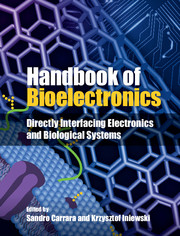Book contents
- Frontmatter
- Contents
- List of Contributors
- 1 What is bioelectronics?
- Part I Electronic components
- 2 Molecular components for electronics
- 3 Nanogaps and biomolecules
- 4 Organic thin-film transistors for biological applications
- 5 Protein-based transistors
- 6 Single-molecule bioelectronics
- 7 Nanoscale biomemory device composed of recombinant protein variants
- Part II Biosensors
- Part III Fuel cells
- Part IV Biomimetic systems
- Part V Bionics
- Part VI Brain interfaces
- Part VII Lab-on-a-chip
- Part VIII Future perspectives
- Index
- References
7 - Nanoscale biomemory device composed of recombinant protein variants
from Part I - Electronic components
Published online by Cambridge University Press: 05 September 2015
- Frontmatter
- Contents
- List of Contributors
- 1 What is bioelectronics?
- Part I Electronic components
- 2 Molecular components for electronics
- 3 Nanogaps and biomolecules
- 4 Organic thin-film transistors for biological applications
- 5 Protein-based transistors
- 6 Single-molecule bioelectronics
- 7 Nanoscale biomemory device composed of recombinant protein variants
- Part II Biosensors
- Part III Fuel cells
- Part IV Biomimetic systems
- Part V Bionics
- Part VI Brain interfaces
- Part VII Lab-on-a-chip
- Part VIII Future perspectives
- Index
- References
Summary
Abstract
Recent research in nanobioelectronic devices has opened up a new wave of enthusiasm in revolutionizing electronic circuit design, marking the beginning of a new era for biomimicry phenomena to advance into high-density logic and memory applications. This chapter describes the formation and development of a protein-based biomemory device composed of recombinant protein variants, together with some experimental results on protein film formation with various readout mechanisms for constructing future memory devices. To elucidate the concept of the memory device, a redox protein in which cysteine residues were incorporated by recombinant technology was immobilized on a gold electrode surface. Application of the correct potentials then causes carrier trapping or detrapping in protein films to occur, as shown by the electrochemical measurements, thus performing the memory function. The chapter also summarizes recent research on nanoscale biomemory devices, considering first the basic nature of the write-once-read-many (WORM) characteristics. The concept of WORM is then extended to multi-bit storage of protein variants and towards development of a nanoscale biomemory device. The fact that these developed devices, operating at very low voltages, can be patterned and addressed locally, and also have good stability with excellent reversibility, makes them a promising platform for non-volatile memory devices.
- Type
- Chapter
- Information
- Handbook of BioelectronicsDirectly Interfacing Electronics and Biological Systems, pp. 86 - 102Publisher: Cambridge University PressPrint publication year: 2015



